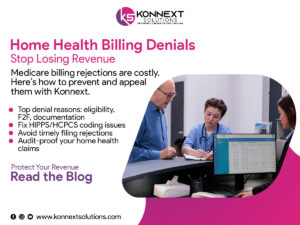How Reducing Billing Delays Can Lead to Healthier Financials and Happier Patients
To operate efficiently, practice owners need more than just clinical excellence—they need consistent cash flow. One of the most overlooked metrics impacting your financial health is the delay between service delivery and claim submission, commonly referred to as lag days.
In this blog, we’ll highlight the importance of tracking lag days, their impact on both revenue and patient experience, and how Konnext Solutions helps reduce lag days for better outcomes across the board.
What Are Lag Days—and Why Do They Matter?
Lag days represent the number of days between when a patient receives care and when that care is billed. According to a recent AMA report, reducing lag days dramatically improves revenue cycle performance by accelerating cash flow and minimizing claim denials.
For instance, one healthcare group reduced its lag days from 30 to 10—and saw a 20% revenue boost in just six months.
Key Strategies for Reducing Lag Days
| Strategy | Example |
| 1. Efficient Patient Documentation | Encourage providers to complete charts within 24 hours of each encounter. |
| 2. Timely Coding & Charge Capture | Train billing staff on updated codes and prompt charge entry. |
| 3. Claims Scrubbing Software | Use tools that automatically detect and correct errors before submission. |
| 4. Streamlined RCM Workflow | Create a clear handoff from front desk to billing to minimize lags. |
| 5. Denials & Appeals Monitoring | Establish a system to quickly track, manage, and appeal denied claims. |
Example:
Dr. John’s internal medicine practice reduced lag days by 30% in just two months by requiring same-day chart completion, introducing regular coder training, and integrating claim scrubbing software to catch issues early.
Lag Days & the Patient Experience
Reducing lag days isn’t just about billing—it also directly impacts your patient satisfaction and continuity of care.
1. Prolonged Lag Days Can Hurt Trust
- Patients waiting for procedures or follow-ups may feel frustrated or anxious.
- Delays can lead to worsening symptoms or missed treatment windows.
- Negative patient perception may reduce retention and referrals.
2. Disruption of Treatment Plans
- Long lag times can affect care coordination, especially for chronic conditions.
- Missed or delayed follow-ups can compromise treatment effectiveness.
3. Mitigation Strategies
- Optimize appointment scheduling and workflow tracking.
- Simplify referrals and improve pre-authorizations.
Keep patients informed with realistic timelines and progress updates.
4. The Proactive Approach Pays Off
- Acknowledge the impact of billing delays on patient experience.
- Invest in systems that shorten time from care to billing.
- Use analytics to catch patterns and implement targeted improvements.
5. Patient-Centered Care = Practice Success
- Faster processing fosters trust and improves communication.
- Responsive operations lead to stronger provider-patient relationships.
Final Thoughts
Tracking and minimizing lag days isn’t just an operational decision it’s a strategic one. Practices that prioritize prompt billing not only accelerate revenue but also deliver better patient experiences.
Konnext Solutions helps providers build systems that reduce billing delays, enhance scheduling efficiency, and secure long-term financial success.
Ready to eliminate billing delays and grow your revenue?
Email us: info@konnextsolutions.com
Call us: 551-261-3456
Konnext Solutions—Smarter Revenue. Better Care.




